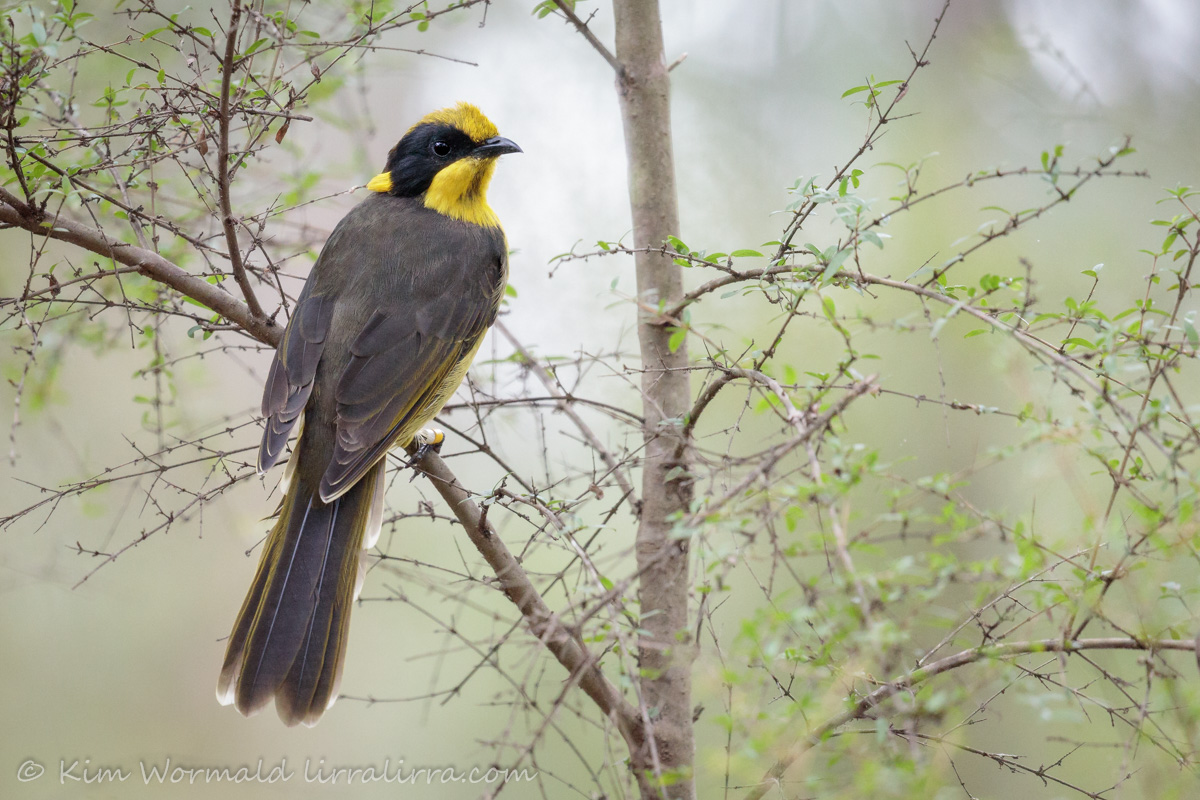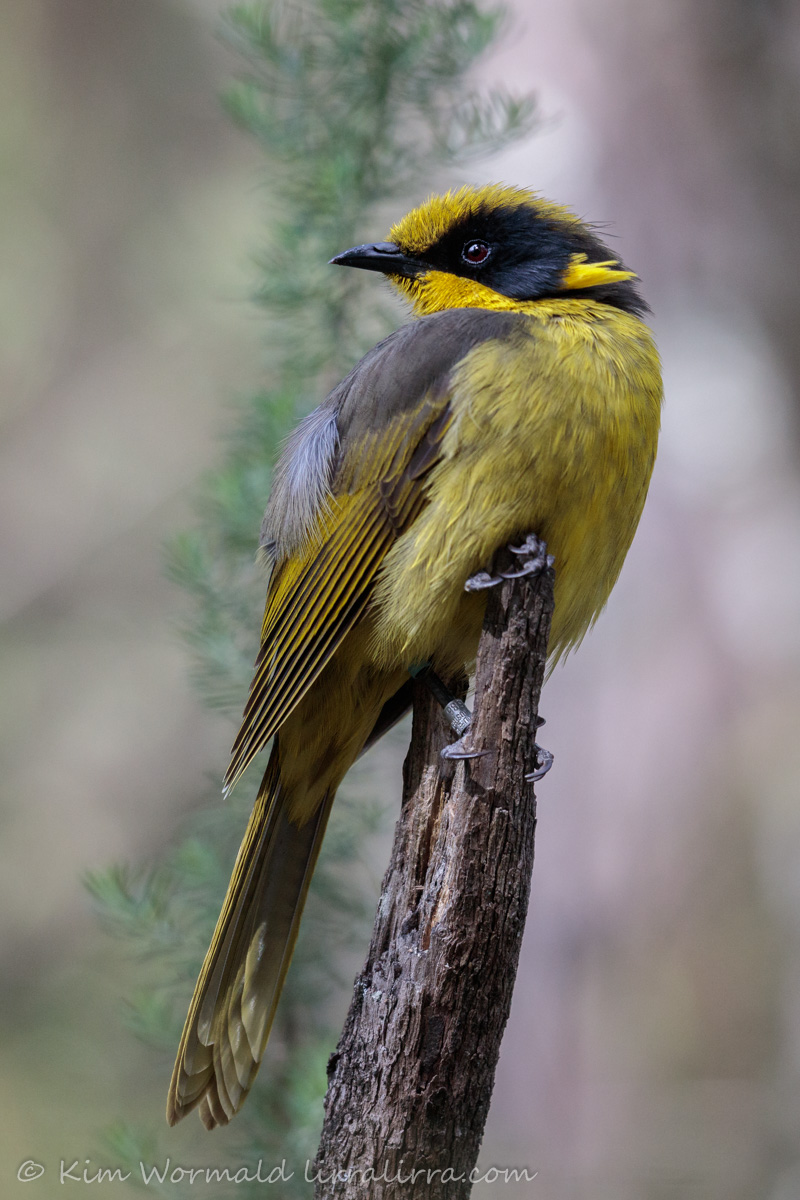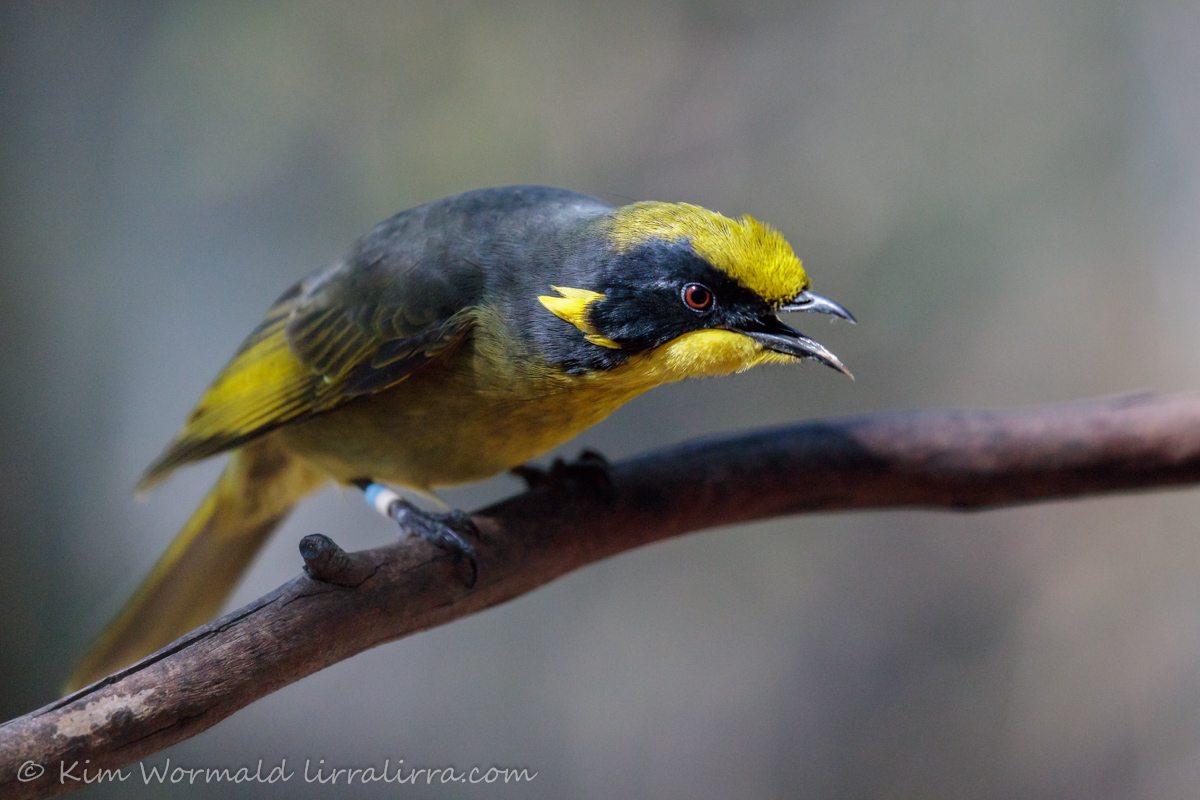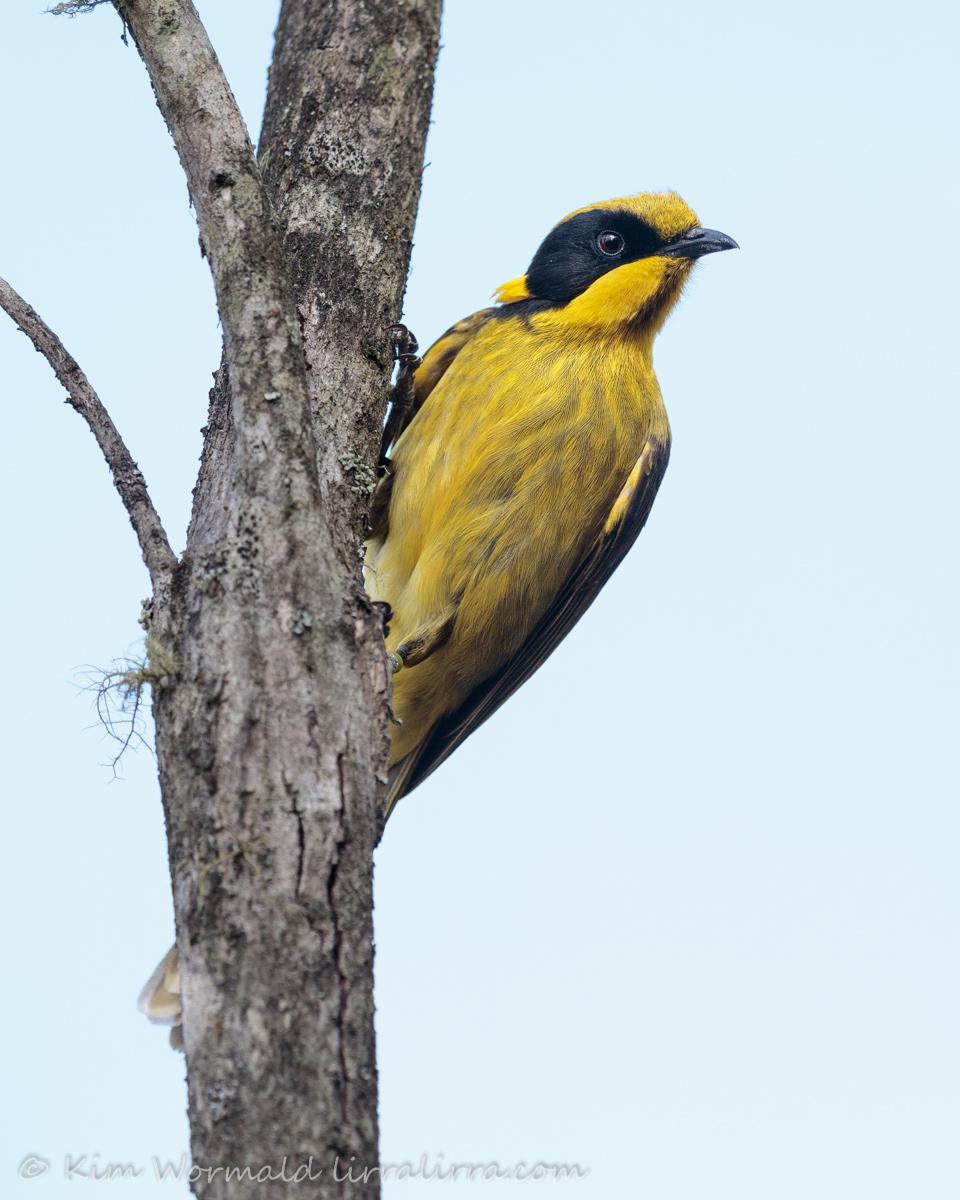There are now three times as many Helmeted Honeyeaters as there were in 1989 when the population reached a critical level of 50 individuals and the recovery program was established.
Helmeted Honeyeater (Lichenostomus melanops cassidix)
1/500, f5.6, ISO 6400, focal length 400mm
As one of the team of feeders involved in the supplementary feeding program at Yellingbo I get the opportunity to see this critically endangered species far more often than I see non-endangered Yellow-tufted Honeyeaters. The first time I saw yellow-tufted it was funny, they are so tiny and much less flamboyant than their showy, helmeted cousins.
The image above was taken with an ISO of 6400. For non-photographers the ISO setting relates to how much light gets through to the sensor and I rarely get an image as clear as this when I’ve used a high ISO, in fact I usually wouldn’t go higher than 1600 for fear of introducing too much digital ‘noise’ to the image. In the bush at Yellingbo the lighting is often challenging for photography and my aim is not to get good images of the birds but to get identifiable shots of their leg bands. The bands we’re most interested in are on the birds’ right foot, this bird is affectionately known as ‘white over yellow’. Sometimes we need to check the bands on the left leg too, these bands relate to which part of the reserve they were hatched in. Every time I check my heho images I have shots of legs only, sometimes I’ve chopped off the bird’s head or wings as I focus on trying to identify the bands.
Helmeted Honeyeater (Lichenostomus melanops cassidix)
1/1000, f5.6, ISO 1600
Hehos often hide their bands and it can take us quite a while to identify individuals. This bird’s right legs bands are hidden but the left bands can be seen, including the green band tucked up amongst its feathers which indicates a bird that was hatched at green site. I particularly like this image and might try it in a competition one day.
Helmeted Honeyeater (Lichenostomus melanops cassidix)
1/1250, f5.6, ISO 3200
At this time of year the hehos are beginning to think about breeding, with the earliest breeders starting their nests in August. They can be aggressive towards each other when breeding pairs are deciding where to nest and begin to vigorously defend their territories. I bet you know this bird’s name, though you might not realise you need to specify ‘light blue’ and in some lighting conditions ‘white’ and ‘light grey’ are horribly difficult to distinguish from each other.
Helmeted Honeyeater (Lichenostomus melanops cassidix)
1/1000, f5/6, ISO 1600
I like the expression on this bird’s face as it pauses for a second to check what’s happening; ie is food about to be served or is a rival bird invading its territory, or both.
Friends of the Helmeted Honeyeater have recently recruited new volunteers to help with the supplementary feeding program but there are still a few spaces to fill. If you would like to learn more please let me know or contact the group. There’s no guarantee you’ll see hehos at every feed, there’s no guarantee that the weather will be reasonable, but the feeding areas are beautiful and every time we feed, something fascinating delights us (leeches are not in that category!).
This week’s post has been delayed as my eldest daughter is unwell, if you believe in prayer or healing energy, please think of her, thank you.
Happy birding, Kim
~ Thank you for visiting and commenting
~ If you would like to join subscribers who receive a weekly email letting them know that lirralirra has been updated please use the ‘subscribe’ box above right





I spent quite a lot of time at Yellingbo looking for these guys, easily the most time I’ve spent looking for a subspecies when I’ve seen the nominate, but without luck. We were lucky enough to spot the Emu-wren & Powerful Owl, but it hurts when you dip on the one you’re looking for.
Brilliant to see the emu-wren and owl Michael. I hope you get another chance to look for Helmeted Honeyeaters soon, and that they show themselves – good luck!
What an interesting bird and so cool they are working to be recovered! I cannot imagine trying to get clear shots of leg bands though so good work.
Getting images of the leg bands can be very comical Sherry. The birds bounce around among the foliage doing their best to keep their right legs hidden, and generally making it as difficult as they can.
Beautiful birds and shots 😊
Thank you beautiful Lilla
ISO 6400 on a 5D MKIII, brave [wo]man, well done. Any processing involved to reduce the noise?
I was using a 5DSR Pauli, and I didn’t do any noise reduction post-processing. I think the general mistiness of the morning helped keep it ‘light’ and disguise the noise – noise is certainly visible in darker shots
I am recovering from a serious car accident and bound to a wheelchair but nothing brings me more joy and happiness than to open your emails and see these stunning and beautiful photos of our magical feathered friends.
Thank you for spreading so much joy and happiness and inspiring everyone to make sure we never create a world where the sight and sounds of birds no longer exists.
I ask everyone who receives your newsletter to please pass it on and in that way introduce someone else to our amazing, unique and priceless wildlife. Their homes and habitats are being destroyed and they need our voices to be raised in protest and we need to fight for their protection and conservation to ensure that our children and grandchildren will not just see these beautiful creatures in a book.
Power to the people and peace to the world.
Barbara
I was very moved by your emotive and beautiful message Barbara, and I thank you for your kind words about lirralirra. Our wildlife certainly does need protection, I feel sad for people who don’t understand the intrinsic value of nature. I can’t imagine being without the joy of seeing the wonderful sights of birds and butterflies, the sweet faces of wallabies peeking through the grasses, tiny spiders going about their business in the centre of blossoms – there are so many wonderful things to see – you are right, we must do all we can to spread the word.
I hope your recovery is straightforward and that you are able to spend time outside enjoying ‘our magical feathered friends’, Kim
Delightful pics Kim of the Hehos and congrats on your part in their recovery. Sending many healing energy spirits for your daughter and your family.
Big hugs
I’m glad you enjoyed the heho images Alison. Thank you for caring about my daughter, I appreciate your kind thoughts very much
superb shots kim
Thanks Glenn
Oh Kim. You are your family are not having a fun time on the health stakes front. Oceans of caring are flooding your way.
Thank you for taking the time out to delight us with the Helmeted Honeyeaters. They are enchanting. And it is wonderful to hear that their numbers are increasing.
Long may it continue.
Thank you for your oceans of caring EC. The hehos are feisty little characters, it’s good to know they’re doing so well.
Thank you for such detailed photo info and photos Kim. Praying for your daughter’s health and wellbeing.
Thank you Toni, my daughter still needs support and I really appreciate you caring about her health and wellbeing
Hi Kim, Absolutely beautiful photos.
I hope your daughters health improves steadily.
Best Wishes to you both.
Carole. 🙂
Hi Carole, thanks for your comments which are as lovely and as much appreciated as always
Hi Kim,
Any chance you could let me know how I could get the privilege of viewing these birds in the wild for myself?
All the best!
Hi James, there is a monthly walk on a Sunday morning in Yellingbo when I believe they are sometimes sighted. The friends group would be able to give you more information on that, I’m in hospital and don’t have the contact’s details with me. Volunteering is a great way to see them but it is a big commitment that doesn’t always fit in with everything else you need to do. Good luck!
Absolutely gorgeous photos
Thank you Marc
Gorgeous pictures! I’m so glad their numbers are going up and well done for being a part of their rehabilitation!
Thanks Alyssa, they are such great little characters
Superb photos again Kim. Inspirational – I think. I’m tempted to go and put my camera away when I see your work, but for now I will persevere. I hope to have a bit of time soon so will have more opportunity to wait for the birds to come to me. Here’s hoping. Thanks for inspiring us with these wonderful shots.
You should definitely get your camera out more not less Neil! I could do a dozen posts a week full of rotten shots of birds.There are many times when I look at images that make me hover between feeling inspired and discouraged. Could you tag me or let me know where you post your images if you get the chance, I know I’ve seen some beauties of yours somewhere on fb.